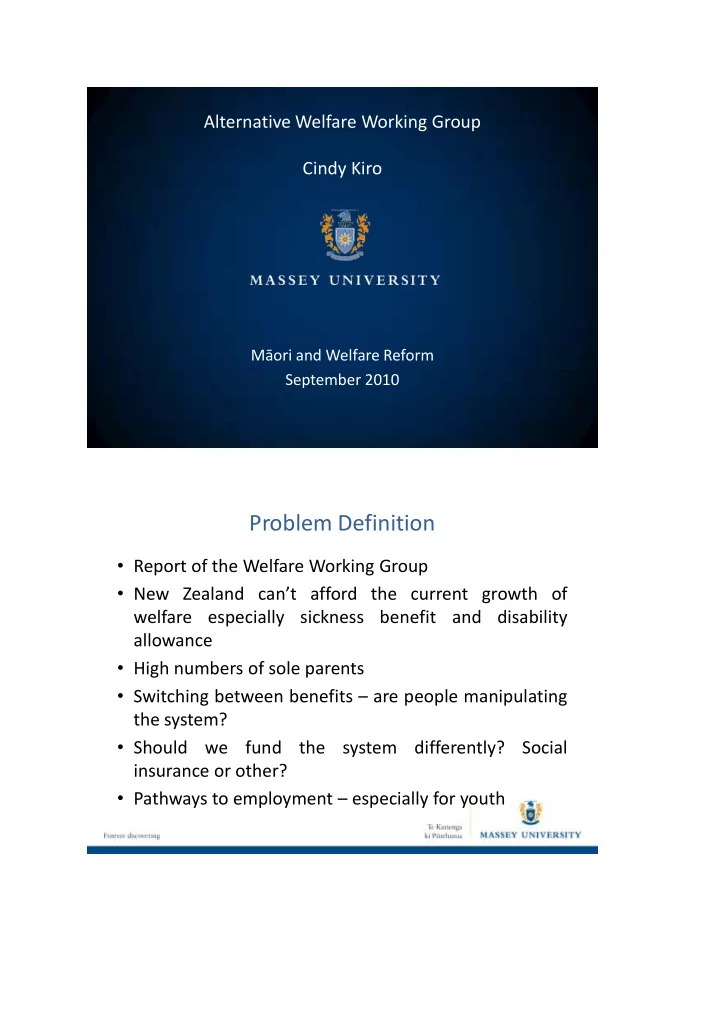

Alternative Welfare Working Group Cindy Kiro Māori and Welfare Reform September 2010 Problem Definition • Report of the Welfare Working Group • New Zealand can’t afford the current growth of welfare especially sickness benefit and disability allowance • High numbers of sole parents • Switching between benefits – are people manipulating the system? • Should we fund the system differently? Social insurance or other? • Pathways to employment – especially for youth
Problem Definition contd. • Inequality -NZ unequal in OECD since late 1980s - Māori and Pacific most deprived • Macro economic environment -Economic recession -Labour Market – jobs harder to get and people work longer hours -Housing un-affordability • Demography -Aging population and reliance on a smaller pool of children - Māori and Pasifika fertility • Culture and Racism
Income changes by decile (BHC) 1988-2001, Deciles 1-9 25% % change at the top of the decile 20% 15% 10% 5% 0% 1 2 3 4 5 6 7 8 9 -5% -10% Decile Source: Perry, Ministry of Social Development, 2010 Policy Mix • Job summit 2009 • Tax reforms – budget 2010 - Corporate and personal income tax cuts - Rises in GST from 12.5 – 15% • Welfare Reform 2010-2012 - Welfare Working Group Forum - likely to target sickness and disability benefits, some unemployment and sole parent entitlements
Māori in the New Zealand Labour Market New Zealand Household Labour Force Survey, Statistics New Zealand 2010 Income inequality and tax rates What about assets inequalities?
% of homes owner- occupied, Auckland, 1986-2006, DPMC 2008 Home ownership rates, 1986-2006 76 74 72 70 1986 68 1991 1996 66 2001 2006 64 62 60 58 1 census years Housing affordability now: The Social Report 2009 Percentage of all household’s paying 30% or more of net income for housing “Using AHC measures (ie taking housing costs into account) child poverty rates rose from 2007 to 2008, after falls from 2001 to 2007. This occurred because housing costs rose sharply from 2007 to 2008, especially for low-income HHs, overwhelming the final BHC gains from the WFF package” Perry 2009
Benefits against average incomes: more marginalisation 800 Net average earnings 600 IB+2 $ per week ($2009) UB+2 DPB+2 400 DPB+1 IB single 18+ 200 UB single 25+ 0 1980 82 84 86 88 90 92 94 96 98 00 02 04 06 08 2010 As at 1 April Source: Perry, Ministry of Social Development 2010
Proportion of All Children Aged 0-17 Years Who Were Reliant on a Benefit Recipient by Benefit Type, New Zealand April 2000-2009 30 25 Percent of Children 0-17 years (%) 20 15 10 Other Benefits Sickness Invalids 5 Unemployment Domestic Purposes 0 2000 2001 2002 2003 2004 2005 2006 2007 2008 2009 Year Seasonally Adjusted Unemployment Rates vs. Numbers of Unemployment and Domestic Purposes Benefit Recipients, New Zealand 1990-2008 12 350 Unemployment Rate 300 Number on Unemployment Benefit 10 (Thousands) Number on Domestic Purposes Benefit 250 Unemployment Rate (%) 8 200 Number of Benefit Recipients 6 150 4 100 2 50 0 0 1990 1991 1992 1993 1994 1995 1996 1997 1998 1999 2000 2001 2002 2003 2004 2005 2006 2007 2008 Year
New Zealand Children: Elderly Natalie Jackson, Centre for Population Studies, Waikato University Natalie Jackson, Centre for Population Studies, Waikato University Investing in demographic ‘dividends’ now
Future labour market/ tax base
Recommend
More recommend